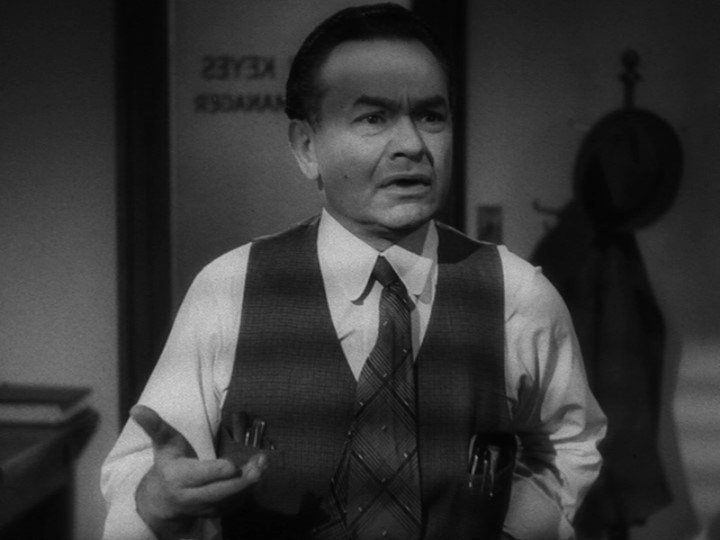
Double Indemnity, made in 1944 by Billy Wilder follows the story of a young insurance man, being roped into the femme fatal's trap in a plot to kill her husband, using accident insurance to earn her money from his demise. What unfolds is a tainted love story between the two star crossed characters, with the ultimate eventuality being their death. The film is designed to emphasise that film noir dark undertone, with the moral issue being raised that murder cannot be gotten away with.
''Keys' asking Neff for spare change''
Opening:
The film opens with a speeding car jumping through the lights. It is dark and there is rain upon the ground. The introduction acts as a fluent caste to present the characters, as well as to set the tone for the Film Noir thriller. The night-scene is typical of the Film Noir genre, and it serves as a perfect introduction to what turns out to be a sinister story of betrayel and murder. We see Neff getting out of the car, at this point un-named and enigmatic, and in terms of mise-en-scene, his coat is carried over his shoulder in an informal fashion, perhaps expressing his callous attitude and mysterious tendencies. Low-key lighting keeps us into the dark as Neff moves into the darkness, with sinister music placed in the background on a low dub, as to not distract from the movie; the music is serviceable as a method of carrying the film along, not dominating it.
The opening narrative in the lift shows that he's not only working late, but also reveals his profession as an insurance broker. The lift-worker seems to look up to him, which is shown in Neff's tallness compared to his, as he towers over him. This represents Neff's higher rank, and his dominating persona. In his office, there is low-key lighting, and there are shadows written across the walls and flooring. Ominous music featuring string instruments can be heard in the background. As he enters the room, we see the silhuotte of his body through the doorway. As he turns a desk-lamp on, his face is illuminated in a frightening way, and his turning on of the lamp, and becoming bringer of the light shows his control over the story. We know that this character is going to be the main focus of the story purely by his perception and presentation, and from this we learn to understand Neff as more than just a fictional creation; he becomes a harbinger of our own emotions across the storyline, and many of the thoughts and feelings that he has are perfectly rational.
The depth of field during the opening varies. Generally, central items are the main focus, with the outside blurred. Occasionally, for example when he dials the phone, the phone becomes the main centre of attention, and Neff himself becomes blurred. There is a narrow depth of field throughout much of the opening, with Neff clearly dominating the scene. We see a long, static shot where he withdraws a pack of cigarettes and begins to smoke one, lighting the match in a particular fashion that is seen throughout the movie at several points, usually during dangerous scenario's, or after something climactic has occured. The initial scene is a flashback, yet set in present time, with a monologue spoken over the top of the ensuing scenes. The opening scene is in fact the same as the ending of the movie, with everything in between a flashback of the last few days, showing how he ended up in his initial situation. He makes references whilst on the phone to Key's, his assistant and close friend, to '[the case]' being 'wrapped up in tissue paper', which is expressed throughout the movie several times, introducing our secondary character, and showing that Key's will be featured throughout the movie as a source of confession to Neff.
The Scene at the House:
There are almost instantly sexual references made when Neff arrives at Phyllis' house. She says ''Is there anything [she] can do for [him]?'', which instantly creates a flirtatious tone to her voice. She is at once presented as the Femme Fatale character within the piece, and we know not to trust her from the very start. The fact that she's wrapped in a towel, having been sun bathing, shows her self-indulgent and flirtatious side, and Neff has no choice but to be captivated by her. She seems to drift between professional and laid back, and she clearly takes control of the situation, knowing exactly what she wants to use Neff for.
As Neff enters the living room, blinds are used with light flashing through, to creates darkened lines on all of the objects within the room, an idea used in other such Film Noir creations, such as 'The Postman always rings twice''. We see Mr. Diedrichson, Phyllis' husband, in one of the photo's upon the mantel piece, and the viewer see's from Neff's perspective, taking his side over the stern, harsh-looking Mr. Diedrichson. As Phyllis strolls down the stairs, there is increased emphasis put opn her legs, slowing panning up to her body, focusing an extra second or two on her chest, showing her intentions with Neff. She is still buttoning her top up as she walks into the living room, showing her flirtatious nature, and as she enters the living room, ready to discuss the plans for her husbands accident insurance, she stands in the darkness, a reflection of what is to come during the rest of the film.
 ''Is that a Film Noir plot device in your pocket, or are you just happy to see me?''
''Is that a Film Noir plot device in your pocket, or are you just happy to see me?''


